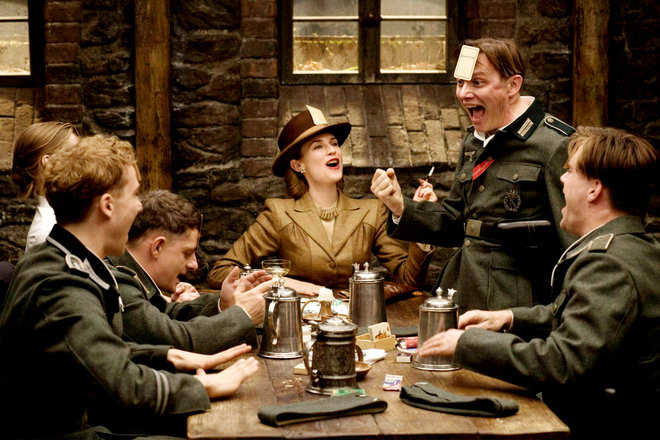
A still from Inglorious Basterds.
Amit Sengupta
The blood and gore in Tarantino’s films is often a revenge against history. This violence is also evident in the cinema of Anurag Kashyap, who is sometimes referred to as ‘Quentin Tarantino of Bollywood’
Once Upon a Time in... Hollywood (yes, with three stylised dots) is the latest and ninth movie written and directed by Quentin Tarantino. Produced by Columbia Pictures and Heyday Films, the film is an international co-production between the United States and the United Kingdom. The black comedy-action drama is located in the counter culture of the 1960s.
The film has two of Hollywood’s finest actors as lead protagonists: Leonardo di Caprio and Brad Pitt, besides Margot Robbie, who sizzled in another Caprio sensation: The Wolf of Wall Street. Incidentally, another great also stars in this much-anticipated movie: Al Pacino.
Significantly, Tarantino has finally liberated himself from the clutches of close associate Harvey Weinstein, who became notorious following a series of sexual abuse allegations against him. The film also stars late actor Luke Perry, who died in March this year.
The documentary or feature narrative of this elusive film is still in the shadows. It has featured in the Cannes Film Festival and is slated for a world premiere in end-July.
Located in the heady ’60s in Los Angeles, the movie moves in a parallel timeline mixing a complex and troubling synthesis of the past and the present. This is the story of an aging television actor and his stunt double, who go on a journey to mark their presence and seek their bit of fame in Hollywood. A huge ensemble of actors arrive in “multiple storylines in a modern fairytale tribute to the final moments of Hollywood’s golden age”.
His last film, The Hateful Eight, meandered in freezing temperatures across an infinite expanse of snow, murders and emptiness. Some critics, however, seem to be impressed with a general “positive view” of this latest Tarantino movie, calling it his “Love letter to ’60s L.A”. Others are not too sure. They feel, perhaps, that the end should not have been the end in the film, a dilemma in some of Tarantino’s classics, where the end seems to be the beginning and the beginning seems to be the end.
Those obsessed with the tide of violence in Tarantino’s films completely miss the fact that the blood, which flows all over the place, and the killings, which move like a compulsive comic strip as in Kill Bill, are often an attempt to create a political unconscious or cinematic inner dream. The blood and gore is often a revenge against history. This violence is also evident in the cinema of Anurag Kashyap, who is sometimes referred to as the Tarantino of Bollywood.
The music in Tarantino’s films touches the soul’s hidden symphonies of unrequited love and longing. That is what the pan flute does in Kill Bill, despite the carnage in the church, the dead bodies in black suits in the Japanese restaurant, the one-woman army with a sword in search of revenge, and finally seeking the man whom she loved. She kills him with two fingers pushed gently and strategically on his heart, her heart still beating for him. Truly, if this is not a return to feminism, what is?
Tarantino’s return to the Nazis, the Gestapo, the SS and Adolf Hitler, using the movie hall and the black and white screen as both metaphors and characters, is also a return to revolution turning history’s stated narrative upside down. In Inglorious Basterds, he does exactly that.
Later in David Letterman show, Tarantino said ‘Basterd’ is ‘Basquiatesque’ adaptation of bastard, and is basically a “Quentin Tarantino spelling”, and he really means no harm to the original meaning of the word, or to the English language dictionary.
Surely, the burning alive and mass killing of Adolf Hitler and the entire fascist state apparatus, that too in a movie hall run by a Jewish girl whose entire family was murdered by the Nazis, is more than a statement of revenge. It is Tarantino’s not-so-subtle way of telling the world that next time a fascist comes by who kills millions in gas chambers and concentration camps, he and his best buddies should be made to die in a similar public spectacle, like a spectacular fantasy within a spectacular movie. Perhaps with a swastika carved on his forehead with a knife.
It is a similar inverse dialectic on slavery and white supremacy which compels Django Unchained to reverse the original historical narrative of suffering, bondage, rapes and deaths. It becomes a tale of pure revenge and liberation. The black man finally finds his redemption with Tarantino. And there is a white man who shows him the way. The medium here is also the message: that next time the whites do it, this is what they deserve.



























